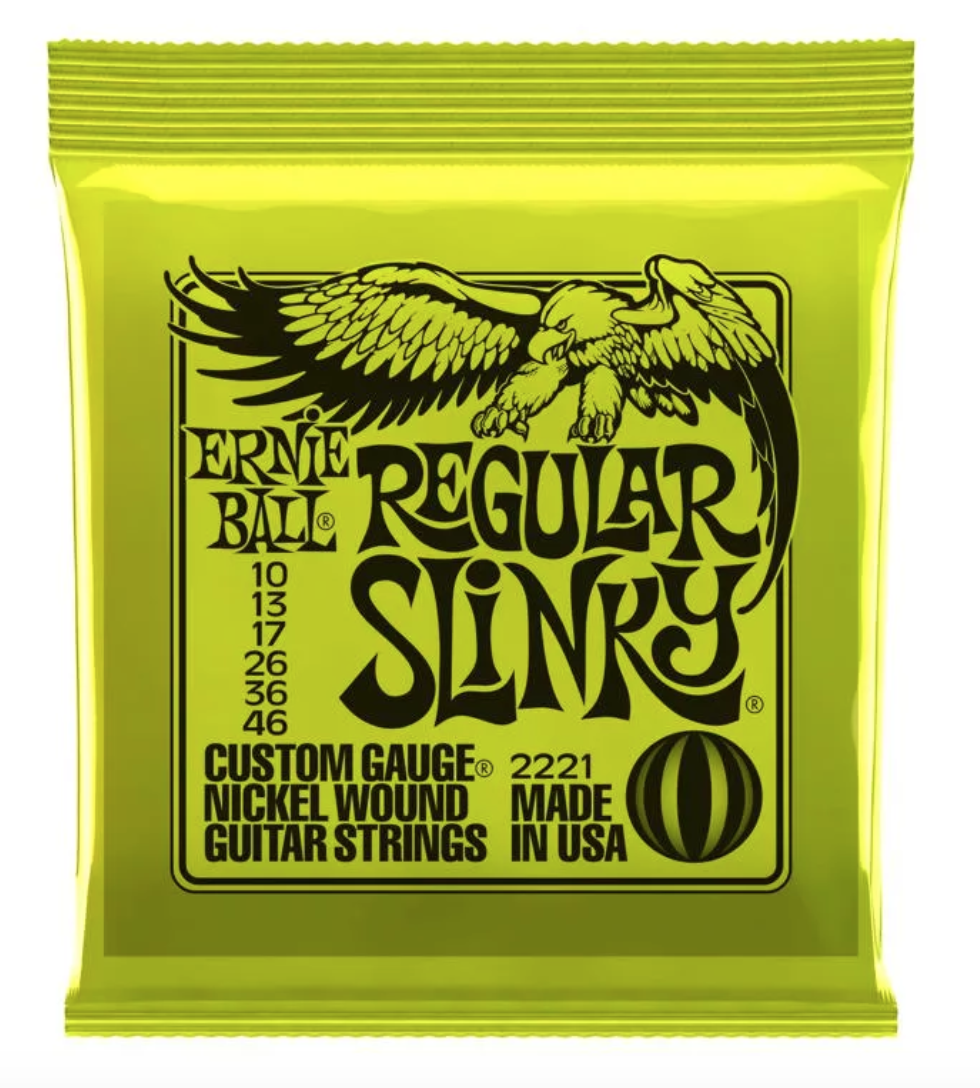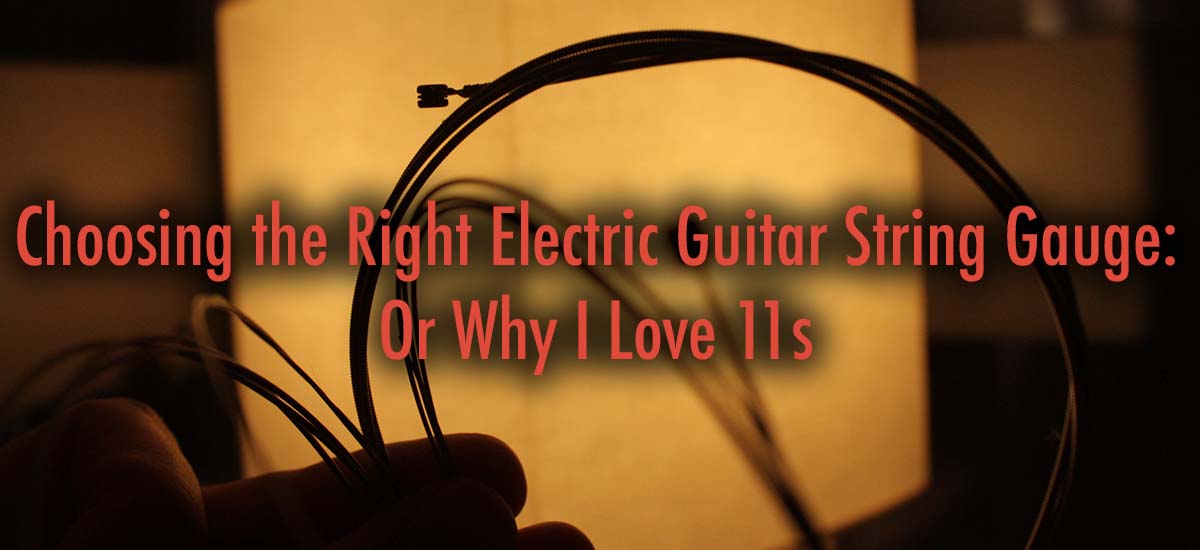If you buy a new electric guitar, most likely it will have 10s on it and will be set up for that gauge of string. You may want to keep them, you may want to change them. Read on to learn what you need to know to choose the right electric guitar string gauge. In this post we’re not going to discuss string types, coatings, or ball ends. We’re only going to get into gauge. Size is everything in this post!
The nickel plated standard
If you buy an electric guitar, there’s a 90% chance that they have nickel plated 10s on it from the factory. The guitar has also been setup for these gauge strings. There is a reason why these strings are the standard across most guitars. They are the perfect middle ground for all styles and playing types.

Are you a metal player? 10s will work. Are you a blues player? 10s will do the job. You get the idea. They are the perfect all around string that will stand up to abuse, sound great, and feel good across nearly every guitar.
Quick side note here. If you ever see a set of strings like this Ernie Balls, this indicates a nickel plated steel string. If it is a pure nickel string it will explicitly say that on the package. NPS strings offer a nice bright, crisp tone that works great for most styles of playing.
What do those numbers mean? 10s, 11s, etc.
When referring to string gauge, we often just say the size of the bottommost string (high e). And saying 10 is the equivalent of 0.010”. Strings are measured by their diameter in inches. A standard set of 10s is made up of .010, .013, .017, .026, .036, .046. Different manufacturers will throw in a different size here and there, but for the most part this is the standard set you’ll see for 10s.
Sometimes you’ll hear people refer to string sets by “light” or “medium.” This is much more common with acoustic strings where a “light” set refers almost always to 12s. Electric strings are less uniform in their set gauge naming, and therefore are almost always called by the numbers.
How string gauge affects playability
One of the most noticeable changes in different string gauges is the feel of the string. The pressure to fret the string, bending, tapping, all are techniques that depend largely on the tension of the string. The heavier the gauge of string, the more tension in pounds that string will need on it to produce the same pitch. That means that 11s are going to feel heavier, or stiffer than 10s. Similarly, 9s are going to feel very light and bendable compared to the standard 10s.

Back to the techniques noted above. If I’m bending a string a lot, it might be pretty nice to have a real slinky string to wiggle around (you might think to yourself). The downside of this is that bends may not have the controlled vibrato effect that a heavier string offers. Having more tension on the string requires stronger fingers, but will generally give better sounding bends when executed correctly. It’s similar to the differences between a Bigsby and a 2 point Strat trem. The Bigsby’s spring is so much heavier that, while you can’t pull of a dive bomb, you get a very smooth vibrato effect that’s hard to replicate with any other vibrato system.
What about just standard notes and chords around a fretboard? Having lighter strings will be easier to fret notes, requiring less pressure. A lighter string also needs a more refined touch. It’s like putting an acoustic player on an electric for the first time. What do they do? They grip so hard that they pull all of the strings painfully sharp. Playing an electric, requires just enough pressure on the string to fret the note cleanly. This is especially true when playing lighter strings like 9s and below.

Below!? What do you mean below? Yep, Billy Gibbons, Jeff Beck, Jimmy Page, and many others played at least 8s in their career if not smaller. This makes it pretty clear that it really comes down to personal preference. Some people love light slinky strings, some people fat twangy cables.
How size affects tone
If you’re testing out different string gauges on an acoustic guitar, you’re going to see a bigger difference in the overall tone and volume. Bigger strings means more tension, more downward pressure on the bridge translates more string movement into the top of the guitar which gives you more volume.
However, when we’re talking about electric guitars, does a bigger string translate to the pickups generating a bigger sound? I don’t have any hard evidence to support it, but there’s no way an 11 would make any appreciable difference in voltage over a 10. The only other thing then would be resonance. A heavier set of strings on an electric will most likely cause the instrument to vibrate more, increasing the sustain. How much is difficult to say, and this effect may be more placebo than anything.
Now, if we’re talking about semi-hollow or hollow body guitars, then there is a clear acoustic quality to those guitars and the effects of different string gauges will be more pronounced.
How size affects the setup
I touched on it briefly above, different string gauges may have significant effects on a guitar’s setup. The most noticeable difference will be in the bridge if the guitar has a tremolo. Strat style or Floyd Roses, called floating bridges, will absolutely have to be readjusted if you’re swapping string gauges. These can be so touchy that the couple pound difference of a different manufacturer, or string batch, will throw off the balance. Especially in the Floyd style.
If you don’t know what you’re doing, take it in and have a guitar tech set it up correctly. Bridge adjustments can go downhill pretty fast and I’ve done quite a few correcting setups from players who have tried to figure it out on their own. There’s nothing wrong with that by the way, you have to learn somehow. And having your tech shame you for a poor setup is one of those ways!

Another important note is that the nut of your guitar may not be cut or filed to the right size. If you try to force a string into a too tight of nut slot you will risk cracking the nut, or having the nut pinch the strings from the side. A pinched string will have a weird, and annoying overtone to it that may be a bit tricky to track down. If you’re considering moving to a heavier gauge, exercise caution when stringing the heavier bottom strings.
My Favorite String Gauge is… 11s!
If you look at a lot of blues and blues rock players, they play a heavier string that is tuned down half a step. I tried this out and fell in love. There is something about the heavy quality of 11s that just feels right to me. Bends, like I mentioned, are smooth, and vibrato is even. You fret the notes with intention and there’s a certain quality that you’re urging out of the string. I find them responsive and quick to give out everything you put into them. I still play around with different types of strings, but my desert island electric is strung with pure nickel 11s.
Now most days I still play 11s but in standard tuning. If you haven’t tried the tune down half a step thing, you will not be disappointed. Buttery is how I’d describe that.
What gauge is right for you?
If you’re just starting out playing, keep whatever strings are currently on the guitar. If you picked it up new, it should be setup correctly for the strings that are on it. One important point, don’t use different strings as a crutch. Having trouble fretting with 10s? Don’t just go down to 9s to make it easier for yourself. Practice with those until your fingers are strong enough to handle it. Then, if you do go down to 9s you’re doing it as a creative choice and not because you physically can’t play a heavier string.
Once you’re feeling comfortable with the standard set, then branch out. Try 9s. Try 11s. Try a different brand or material. String gauge is a personal choice, and you’re going to have to make that choice for yourself.
Feeling stuck or bored?

Playing with different types of strings is an awesome way to unlock some different sounds, techniques, or inspire different parts of your playing. I really like Ernie Ball skinny top heavy bottom (look out for that nut, it might not be cut for that low 52) strings which have a chunky low set of strings matched to a top set of 10s. If you’re not bending a ton, try out a wound 3rd (often an optional string with 11s and 12s) for a mellower g. Go the Led Zep route and try some 8s, who knows you might just love them.
As always, thanks for reading and make sure to pick up your guitar today!
